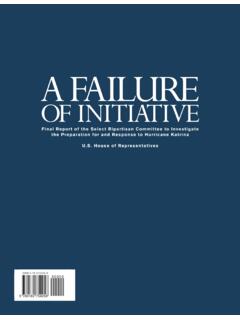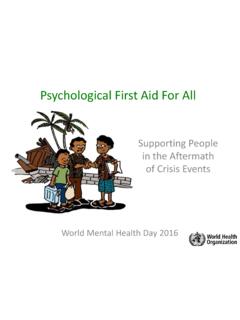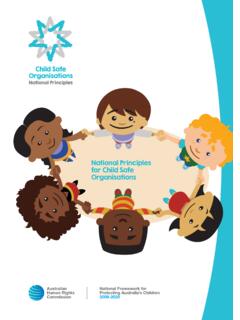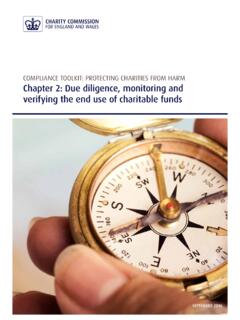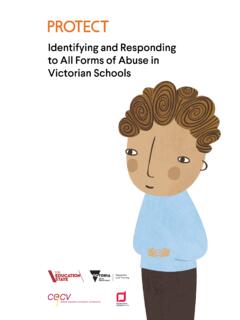Transcription of The Guide: Identifying Vulnerable Older Adults and Legal ...
1 Identifying Vulnerable Older Adults and Legal Options for Increasing Their Protection During All-Hazards Department of Health and Human ServicesCenters for Disease Control and PreventionA Cross-Sector Guide for States and CommunitiesContact Information Centers for Disease Control and Prevention Healthy Aging Program4770 Buford Highway, F-15 Atlanta, GA 30341 Telephone: 1-800-CDC-INFO (232-4636); TTY: 1-888-232-6348E-mail: CitationCenters for Disease Control and Prevention. Identifying Vulnerable Older Adults and Legal Options for Increasing Their Protection During All-Hazards Emergencies: A Cross-Sector Guide for States and Communities. Atlanta: Department of Health and Human Services; information contained in this document does not constitute Legal advice. Use of any provision herein should be contemplated only in conjunction with advice from Legal counsel.
2 Provisions may need to be modified, supplemented, or replaced to ensure appropriate citation to or compliance with relevant local and state laws, to accurately reflect the intent of parties to a particular agreement, or to otherwise address the needs or requirement of a specific site addresses of nonfederal organizations are provided solely as a service to readers. Provision of an address does not constitute an endorsement of this organization by CDC or the federal government, and none should be inferred. CDC is not responsible for the content of other organizations Web Vulnerable Older Adults and Legal Options for Increasing Their Protection During All-Hazards EmergenciesA Cross-Sector Guide for States and Department of Health and Human ServicesCenters for Disease Control and Preventionii Contents iiiCONTENTS Executive Summary.
3 VIntroduction ..1 The Older Adult Population ..2 Definitions ..3 Vulnerable Populations ..4 Overarching Considerations ..7 Developing and Reviewing Selected Legal Authorities ..9 Defining Categories of Emergencies and Hazards ..13 Using Operational Models of Emergency Management ..14 Strategies and Options for Identifying Vulnerable Older Adults ..15 Characterizing the Population ..15 Using Geographic Information Systems (GIS) ..16 Building, Maintaining, and Using Registries ..18 Using Shelter Intake Procedures to Identify Vulnerable Older Adults ..20 Action Options ..25 Moving Forward ..35 References ..37 Appendix A. How This Guide Was Developed ..39 Work Group Guidance ..39 Internet and Database Research ..40 Field-Based Research ..40 Appendix B. Glossary ..43 Acknowledgments ..Inside back coveriv Executive Summary vExecutive SummaryIntroductionWe cannot accurately predict which groups of people will be most affected by future emergencies.
4 However, recent events have shown that some characteristics of Older Adults put them at greater risk of illness and death during many types of emergencies. For example, Older Adults may have impaired mobility, diminished sensory awareness, multiple chronic health conditions, and social and economic limitations all of which can impair their ability to prepare for, respond to, and adapt during An emergency or disaster also can disrupt vital support systems that Older Adults rely on. For many Older Adults , independent living is made possible only with help from friends, family, and in-home services that provide meals, home-based health care, and help with the activities of daily such as Hurricane Katrina in 2005 and the earthquake and tsunami in Japan in 2011 showed how Vulnerable Older Adults can be during emergencies. Unfortunately, research conducted for this guide found three major limitations to our ability to plan for and protect Older Adults : Many different strategies are being used to identify Vulnerable Older Adults across the country, but none of these strategies have been evaluated.
5 No consensus exists on the best way to identify and protect Older Adults . Gaps exist in Legal mandates to protect Older guide is intended to help close many of the gaps in emergency planning and preparedness for Vulnerable Older Adults . In particular, it aims to give public health officials, the Aging Services Network, emergency management personnel, and essential partners from other sectors and at all jurisdictional levels (community, regional, tribal, and state) the critical information, strategies, and resources they need to improve the planning for and protection of Vulnerable , community-dwelling Older Adults during all types of emergencies (often referred to as all-hazards emergencies).Overarching ConsiderationsSeveral overarching considerations must be taken into account when planning for Vulnerable Older Adults during emergencies.
6 For example, planning officials should Include Older adult issues and needs when developing preparedness plans. These plans should identify essential agencies, organizations, and other stakeholders. Identify and review relevant Legal authorities. Define the different categories of emergencies and hazards to better understand how specific emergencies may affect Older Adults in the community. Use operational models of emergency management to identify the specific needs of Older Adults during each phase of an and Options for Identifying Vulnerable Older AdultsTo develop this guide, we conducted research, solicited input from a cross-sector work group of subject matter experts, and collected information during site visits in different parts of the country. We found that none of the methods currently being used to identify Older Adults who may need help in an emergency have been evaluated.
7 Vi Executive SummaryThese methods are as follows: Characterizing the population: Basic epidemiologic data can be used to guide planning for the delivery of services, medications, durable medical equipment, and other materials needed to support Older Adults during all phases of an emergency. Using geographic information systems (GIS): GIS mapping technology allows officials to coordinate information about the locations of Vulnerable Older adult populations, community resources to help Older Adults , and potential hazards. Understanding where Older Adults are located and how they might be adversely affected by different types of emergencies can help local planners and first responders prepare for how they will meet the needs of Older Adults during an emergency. Building, maintaining, and using registries: Registries can be developed to provide information about specific types of help such as medical equipment, transportation, or evacuation assistance that Vulnerable Older Adults will need during an emergency.
8 They also can serve the broader purpose of Identifying Older Adults who might need any type of help in an emergency. Using shelter intake procedures to identify Vulnerable Older Adults in the community: This information can be used to identify Older Adults who may need special help. Action OptionsThis guide outlines specific actions that can be taken at community, regional, tribal, state, and national levels to identify Vulnerable Older Adults and plan for their needs during an emergency. These action options are organized into the following categories: Develop Plans. Collaborate with Partners. Collect and Use Data. Conduct Training and Exercises. Build, Maintain, and Use Registries. Use Law-Based Solutions. Prepare Older Adults and Caregivers. Shelter Older Adults . Take Action at the National Highlights and ResourcesThroughout this guide, we will provide examples from states, communities, and existing programs that demon-strate practical options for addressing the gaps in preparedness planning.
9 These examples will cover topics such as developing plans for rural areas, building community partnerships, leveraging the influence of area agencies on aging, and using technology to plan for Older Adults needs . These examples also serve as models for action and highlight existing resources that might be helpful to professionals working with Vulnerable Older Adults . Moving ForwardCDC and its work group partners hope this guide can help those involved in emergency preparedness planning at all levels understand the unique needs of Older Adults . This publication is also intended to offer specific strategies and options for Identifying and protecting Vulnerable Older Adults during all-hazards more information, resources, and practical tools, visit our companion Web site at Introduction 11 INTRODUCTIONWe cannot accurately predict which groups of people will be most affected by future emergencies.
10 However, events such as the 2005 hurricane season and the 2011 earthquake and tsunami in Japan have shown that some characteristics of Older Adults put them at greater risk of illness and death during many types of emergencies. For example, Older Adults may have impaired mobility, diminished sensory awareness, multiple chronic health conditions, and social and economic limitations all of which can impair their ability to prepare for, respond to, and adapt during also can disrupt the support systems that many Older Adults rely on. For many Older Adults , independent living is made possible only with help from friends, family, and in-home services that provide meals, home-based health care, and help with chores and personal care needs . In fact, the majority (93%) of Medicare enrollees aged 65 years or Older live in the community, rather than in nursing homes or other congregate settings.












